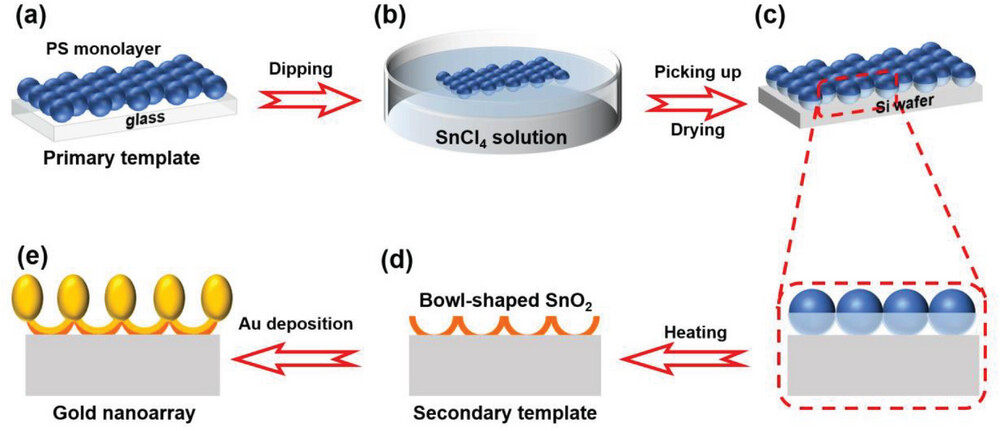- Home>
- Achievements>
- Research Papers
Periodical: ADVANCED MATERIALS TECHNOLOGIES
Page:
Full text link: https://onlinelibrary.wiley.com/doi/10.1002/admt.202400019

A facile and versatile methodology is developed for the synthesis of diverse gold nanostructured arrays employing an oxide secondary template combined with sputtering deposition. A bowl-shaped tin oxide-built array, with fine structure on its bowl edges, is first designed and prepared by solution-dipping of an organic colloidal monolayer, drying, and heating treatment. This array is then used as a secondary template for a gold nanostructured array by sputtering deposition on it. By controlling the solution's concentration and drying rate to adjust the fine structure of the secondary template, various new gold nanostructured arrays with hexagonal arrangement are fabricated, including "graphene-structured" gold nanoarray, non-contact nanoparticle's ring array, closely contacted nanoring array, and bowl/nanoparticle binary composite nanoarray, achieving the structural diversity and morphological tunability of nanoarrays. Additionally, these gold nanostructured arrays can transition from hydrophilic to hydrophobic properties solely by adjusting their surface architecture. Importantly, the bowl-shaped structural units within these gold nanoarrays demonstrate a marked capability for capturing target molecules that can only very weakly interact with plasmonic metals. This work offers an efficient route to achieve the structural diversity of nanoarrays, which is of significance in designing and fabricating foundational materials for the next generation of multifunctional nanodevices.
A variety of gold nanostructured arrays are fabricated based on bowl-shaped tin oxide secondary templates with fine structure on their bowl edges, including "graphene-structured" nanoarray, non-contact nanoparticle ring array, closely-contacted nanoring array and bowl/nanoparticle binary composite nanoarray, achieving the structural diversity and morphological modifiability. These nanoarrays have exhibited structure-induced hydrophilic-hydrophobic transition and target molecular trapping effect. image
Next: Vortex Engineering on Oxide Bowl-Coated Oxide/Gold Dual-Layer Array for Dual Electrical/Spectroscopic Monitoring of Volatile Organic Compounds
